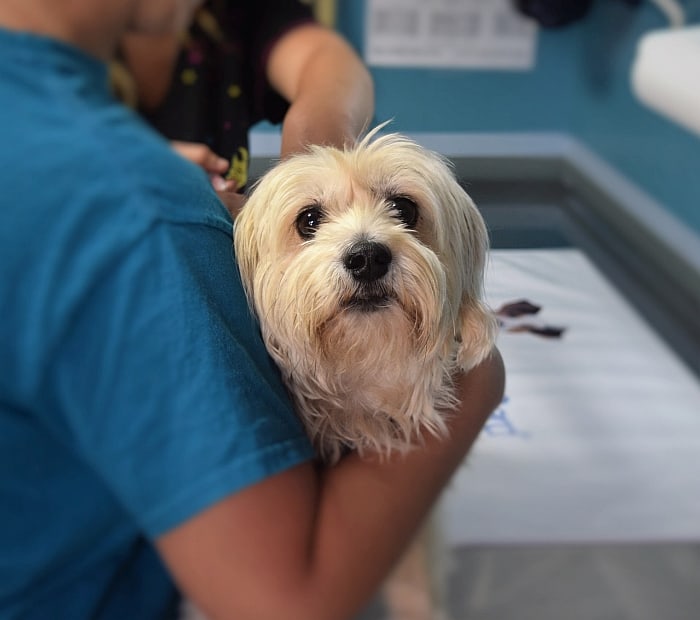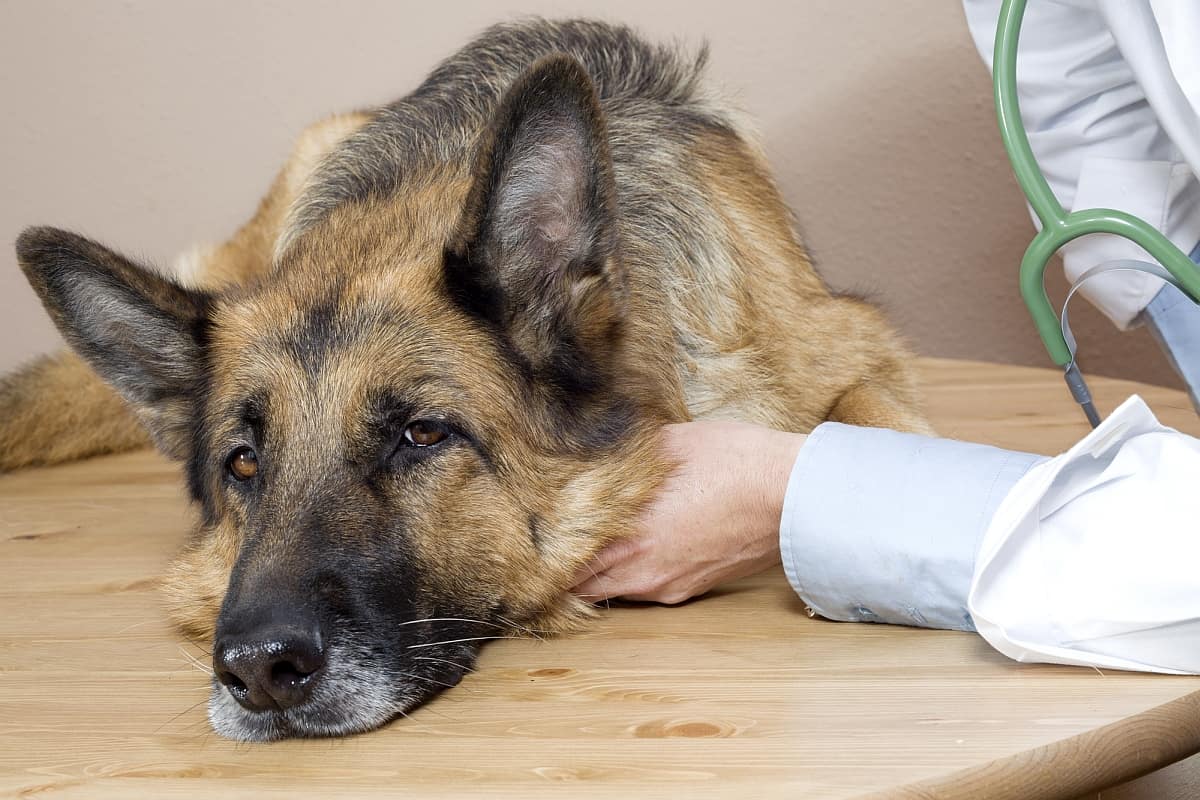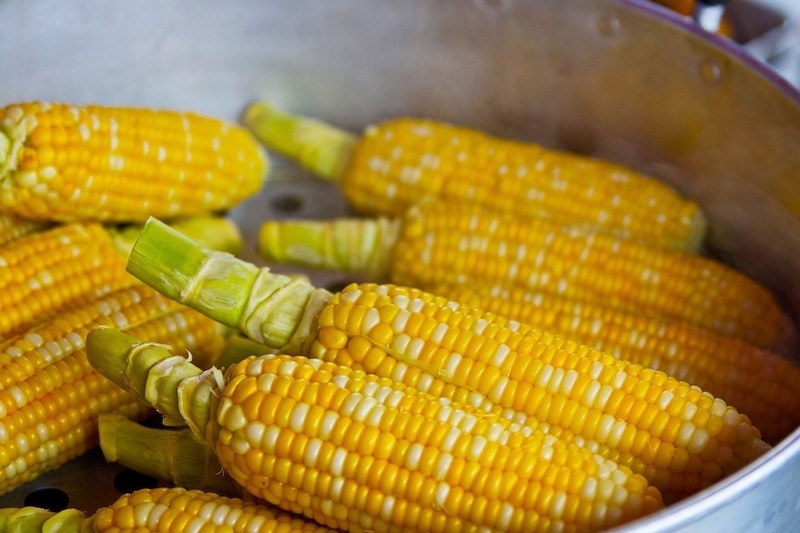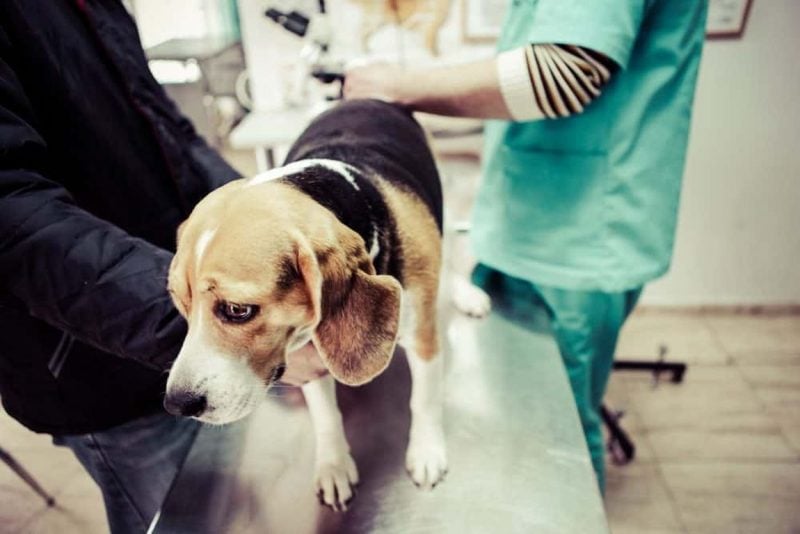Dogs are notorious for eating things they aren’t supposed to.
This can include everything from chowing down on your cat’s kibble, eating a pencil left lying around, to even devouring a corn cob from the garbage. They just aren’t very discriminating when it comes to food marginally edible items.
Because they are often drawn to delicious-smelling treats, gum is another one of the items dogs frequently eat.
Unfortunately, this can cause them serious health problems, depending on the type of gum involved.
Key Takeaways: My Dog Ate Gum! What Do I Do?
- While no gum is “good” for dogs, some are much more dangerous than others. The primary concern is that some gums (mostly sugar-free varieties) contain xylitol, which is very dangerous to dogs.
- You’ll want to solicit immediate veterinary care if your dog has consumed gum containing xylitol. It’s also wise to contact your vet if your dog is exhibiting signs suggestive of xylitol ingestion, such as lethargy, tremors, or a rapid heart rate, among others.
- A variety of other products contain xylitol; gum isn’t the only potential danger in your home. In addition to a variety of sugar-free sweets, things like supplements, medications, and breath sprays may also contain the dangerous sugar substitute.
Sugar-Free or Regular Gum? An Incredibly Important Question
The first thing you must determine when confronted with a dog who has eaten chewing gum is the type of gum that was consumed by your canine. Specifically, you need to determine whether it was a sugar free gum or regular gum that relies on good old-fashioned sugar to make it sweet.
This is important because many sugar-free gums contain the ingredient xylitol, a substance harvested from various plants and trees, which is very toxic to dogs.
Dogs who consume even small amounts of this powerful sugar alcohol found in sugar free gum may quickly suffer from potentially fatal blood sugar levels, thanks to the rapid release of insulin into the bloodstream. Without prompt medical care, liver damage often follows, offering even further danger.
On the other hand, regular gum is typically not a gigantic problem for pooches. It can cause intestinal upset, and it may even lead to an obstruction (particularly if your dog is small and consumed a large quantity of gum). However, most dogs will pass the gum without much drama. Just be sure to monitor your dog closely and solicit your vet’s advice if she shows any signs of discomfort, distress or signs of an intestinal blockage.
Xylitol, Sorbitol, Maltitol and other Sugar Alcohols
Xylitol isn’t the only sugar alcohol found in human foods – there are a number of other common sugar alcohols as well, including sorbitol, maltitol and erythritol.
Fortunately, these are typically considered non-toxic to dogs. However, they may cause problems if ingested in significant quantities (and even small quantities may cause gastrointestinal upset), so avoid giving them to your dog anyway.
It is also important to note that some foods contain more than one of these ingredients. In these cases, the manufacturer may not identify the specific ingredients included. Instead, they may simply label them as “sugar alcohols.” Obviously, because of the potential danger, any foods containing “sugar alchohols” should be treated as potentially toxic for dogs.
And look, I’m as bad as anyone about giving my dog people food, but our dogs really don’t need anything super-sweet in the first place.
If you feel compelled to treat your dog’s sweet tooth, give her a carrot or a blueberry or two. These types of foods are already crazy sweet – they just don’t taste that way to us because most people eat a ton of sugar, so our taste buds are a bit desensitized to it (try going without sugar for a few weeks — your taste buds will reset and you’ll realize just how sweet most fruits are).
Symptoms of Xylitol Poisoning in Dogs
Xylitol poisoning symptoms often appear quite quickly, within just 30 – 60 minutes of consumption. Occasionally symptoms can manifest 12 hours or so after ingestion, so don’t let your guard down after just a few hours.
Some of the most common signs and symptoms include:
Lethargy
Weakness
Listlessness
Incoordination
Rapid heart beat
Vomiting
Seizures
Tremors
Intestinal upset
I have a hard time even writing it, but yes – death can also come as a result of xylitol poisoning.
There’s no doubt about it: Xylitol poisoning is serious stuff. And because it wreaks such rapid havoc in your dog’s body, there is no time to sit around trying to interpret these symptoms.
If you suspect your dog consumed xylitol and she exhibits any of these symptoms act with haste.
Call your vet or the Pet Poison Hotline immediately.
Foods and Products that Frequently Contain Xylitol
You’ll need to check the ingredient list to be sure, but many of the following types of food are made with xylitol, and should be considered off-limits for your pup.
Sugar-free gums
Sugar-free candy
Yogurts
Mouthwashes
Toothpastes (opt for a dog-friendly toothpaste instead)
Breath sprays
Baked goods (especially sugar-free baked goods)
Foods prepared for diabetic people
Medications
Supplements
Certain peanut butters
Jell-O
Protein bars
Factors That Influence the Severity of Xylitol Poisoning
I don’t mean to be alarmist about xylitol poisoning, but I do want to clearly convey the seriousness of the problem – dogs can get very, dangerously sick from xylitol.
However, many dogs recover quickly and fully with suitable veterinary care, so as long as you act quick, your pooch should be OK if he does end up chowing down on some sugar-free gum.
Some of the factors that influence the severity of xylitol poisoning include:
The Size of Your Dog
Larger dogs have more body mass and have larger livers than smaller dogs do, which means that they are more likely to recover from eating a given quantity of sugar-free gum than a smaller dog will (this is also why a small amount of even dark chocolate likely won’t cause trouble for a large dog, although it can be deadly for a more petite pooch).
The Amount of Gum Consumed
As toxicologists love to say, “the dose makes the poison.” The more xylitol your dog consumes, the harder her road to recovery will be. However, it really doesn’t take much xylitol to cause big problems, such as elevated insulin levels.
As little as one-tenth gram of xylitol per kilogram of body weight can cause dangerously low blood sugar. That means that your 22-pound (10 kilogram) dog need only eat one lowly gram of xylitol to end up in the vet’s office. Some sugar-free gums contain more xylitol than this in a single piece.
Dogs aren’t the only animals affected by xylitol – xylitol is actually dangerous for a number of non-human species, but it’s especially toxic to dogs. Mice, for example, can tolerate roughly 200 times as much xylitol (relative to their body weight) as dogs can.
Fresh Vs. Chewed
If you’ve chewed a piece of sugar-free gum for a while, you’ve probably already sucked most of the xylitol out (and just to be clear – xylitol is completely safe for humans).
This means that ABC gum is much safer for dogs than fresh-out-of-the-pack stuff. However, even chewed sugar-free gum represents a potential danger that necessitates a call to the vet. While larger dogs will likely be fine, always reach out to your vet to be safe.
Pre-Existing Medical Conditions
Dogs suffering from a variety of pre-existing medical conditions may suffer from especially dangerous cases of xylitol poisoning.
Dogs who are already hypoglycemic or suffering from liver disease, diabetes, or pancreatic disorders are at even greater risk of becoming sick from xylitol. Be sure your vet is aware of any medical conditions afflicting your dog when you call.

Dog Xylitol Poisoning Treatment
Your vet may recommend a variety of different approaches to treat your dog, depending on her symptoms and the amount she ingested.
Sometimes, they will encourage owners to induce vomiting before taking off for the hospital, by administering hydrogen peroxide. Most vets will recommend administering about 1 milliliter of 3% hydrogen peroxide per pound of body weight, with a maximum dose of 45 milliliters, no matter the size of the dog, but be sure to follow your vet’s instructions.
Once at the office, the vet will take your dog’s vitals and recommend a course of action. Your vet may administer activated charcoal to help absorb the xylitol in your dog’s digestive tract, and he or she may also administer dextrose to help stabilize your dog’s blood sugar levels.
Your vet will have to monitor your dog’s blood sugar levels closely for an extended period of time, as well as her liver function. Because some dogs also suffer from clotting problems after eating foods containing xylitol, blood transfusions are occasionally necessary.
Chewing Gum Safety
As with most other health problems, it is better to avoid xylitol poisoning than to try to treat it.
Accordingly, you’ll want to take every reasonable step possible to prevent your dog from getting her chompers on xylitol-containing items.
This includes:
Use care when discarding chewing gum. Don’t just throw your chewed gum on the top of the trash. Wrap it up well and bury it down deep, so your pup doesn’t pluck it off the top. You may also want to purchase a pet-proof trash can for additional safety.
Be careful while walking your pooch. Unfortunately, a lot of people just chuck their used chewing gum out the window when driving, so keep a good eye on your pup while going on walks in urban and suburban areas.
Don’t leave packs of gum around the house. This is a pretty obvious suggestion, but just get in the habit of storing your gum in places your dog can’t reach.
Consider switching to regular gum. If you’re a little scatterbrained, and you don’t trust yourself not to make a mistake, just switch to regular gum. Your dentist will probably hate this advice, but your vet will approve, so…
***
Have you ever been faced with the horror that is dog xylitol poisoning? We’d love to hear your experiences, if you are comfortable sharing. Many owners are unfamiliar with the dangers xylitol poses, so it is always good to get the message out there as much as is possible.









Leave a Comment